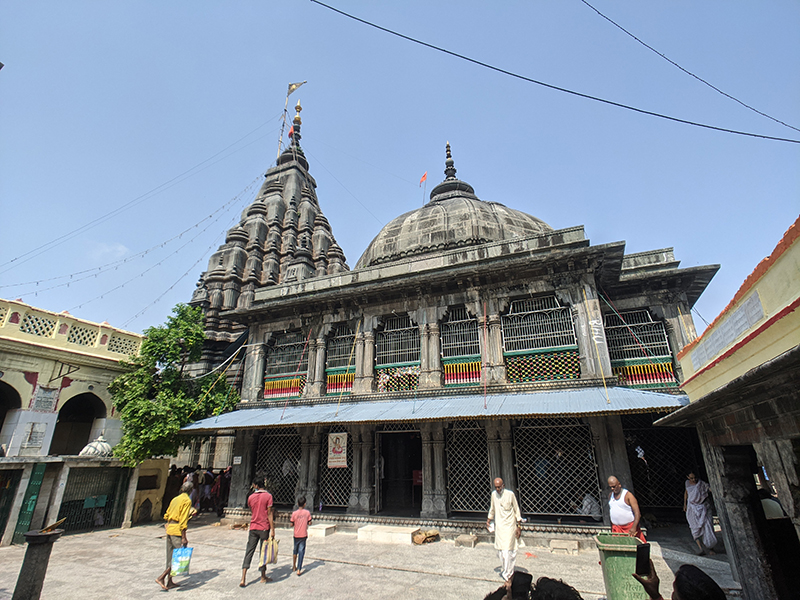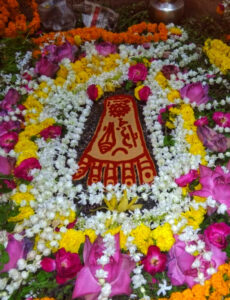
Vishnupada Temple of Gaya is famous all over the world for conducting Shraddha rites for the ancestors. The temple is dedicated to Lord Vishnu housing His actual lotus footprint. The very word ‘Vishnupada’ implies the lotus feet of Lord Vishnu.
Located on the banks of the sacred Falgu river in Gaya, the second largest city in the Indian state of Bihar, there is no single day on which a person would not conduct shraddha rites here. It is believed that offering pind-daan here guarantees liberation for one’s ancestors. Lord Rama had done the shraddha rite for King Dasharatha here.
Though there are other holy spots in Gaya such as Akshaya Vata, Gaya Gadhadhara temple, etc. the Vishnupada temple is the central attraction. The Gayawal Brahmins, who come in the line of Srila Madhvacharya, look after the temple worship and the shraddha rites.
Eminent saints including Srila Madhvacharya, Sri Chaitanya Mahaprabhu, Sri Vallabhacharya, etc., have sanctified the temple further with their visits.
Lila of Vishnupada Temple
The Vayu Purana narrates the lila of the appearance of the Vishnupada temple in a conversation between Narada Muni and Sanatkumara, one of the four Kumaras.
The sacred city of Gaya was named after an asura by the name Gayasura, who was the strongest among asuras. He had a height of 125 yojanas and a girth of 60 yojanas. He is remembered as the excellent among devotees of Lord Vishnu.
Gayasura once performed very hard penances on the Kolaahala mountain (Brahmayoni hill including Mundaprishtha at Gaya now). Without breathing, he remained steady for thousands of years. The devatas became very concerned at this as they could lose their positions if Gayasura became powerful.
All the devatas headed by Lord Brahma and Lord Shiva went to meet Lord Vishnu in Vaikuntha. Lord Brahma and Lord Shiva could not find any solutions themselves.
When Lord Vishnu was told about Gayasura’s penances, He asked everyone to reach the place where Gayasura was performing penances. Lord Vishnu followed everyone seated on His Garudavahana. Reaching Gayasura’s place, Lord Vishnu asked Gayasura about the boon he wanted.
Gayasura replied that he wanted to be holier than the devatas, Lord Shiva, brahmanas, sages, rivers, mountains, yagnas, mantras, karmis, dharmis and gyanis. His request was granted by Lord Vishnu. Thereafter, every person on the planet who came and touched Gayasura or even saw him went to Vaikuntha.
Gayasura’s body becomes the yagna-kunda
The three worlds became vacant including the abode of Lord Yamaraja. Being concerned, Yamaraja along with the other devatas went to Lord Brahma and asked him to take back all the positions and power bestowed on them. There was no use of them as everyone has gone back to Vaikuntha.
Hearing the plight of the devatas, Lord Brahma went to meet Lord Vishnu with all of them. He conveyed the concern to Lord Vishnu, who advised Lord Brahma to go and ask Gayasura for his body to perform yagnas.
Gayasura stood up to greet Lord Brahma and the devatas when they arrived to meet him. He offered to carry out any work for Lord Brahma.
Lord Brahma told Gayasura that no place on earth was as holy as Gayasura’s body for conducting yagnas due to the blessings of Lord Vishnu. Hence, he requested Gayasura for his body to perform yagnas.
Gayasura happily agreed to Lord Brahma’s request and thus laid down on the ground in the south-western direction on the Kolaahala mountain. After placing his head in the north and feet in the south, Gayasura lay there. Lord Brahma arranged all the items needed for the yagna and mentally created the priests required to conduct the yagna.
After creating the priests and brahmanas, Lord Brahma performed the yagna on the body of Gayasura. After completing the yagna including the purnahuti and avabhrta bath, Lord Brahma ordered the sacrificial post to be brought and fixed in the Brahmasaras, the most excellent of all lakes.
Lord Brahma told Yamaraja that he should go and get the stone slab present in his house. This slab would be placed on the head of Gayasura. Yamaraja did as told but the asura was shaking.
On Lord Brahma’s request, the devatas and Lord Shiva stood on the slab. They pressed very hard with their feet on the slab. Yet the asura was still shaking.
Distressed at this, Brahma went to Lord Vishnu and explained the matter. Immediately, Lord Vishnu created His own Deity and handed it over to Brahma asking him to place it on the slab. After acting as per the instructions of Lord Vishnu, the asura was still shaking.
Then Brahma invoked Lord Vishnu, who came down from Vaikuntha and stationed Himself on the slab as Janardhana and Pundarika. Holding His celebrated Gada i.e. mace, He stood on the slab to stabilize the body of Gayasura.
Thus, the lotus footprints of Lord Gadadhara got imprinted on the slab. The temple which was built over these footprints became the Vishnupada Temple.

Deity of Vishnupada Temple
At the Vishnupada temple, Lord Vishnu is worshipped in the form of His lotus foot-print known as the Vishnupada. Devotees pray and offer their respects to the Vishnupada.
The 40 cm long Vishnupada is imprinted on a rock and surrounded by a silver-plated basin. Nine symbols of Lord Vishnu adore the Vishnupada including the Shankha, Chakra, and Gada.
Architecture of Vishnupada Temple
The current temple structure was built by Queen Ahilyabhai Holkar of Indore in 1787. The Queen had crafted the temple and sent her officers to search for the best stone available to build the temple.
Craftsmen were brought from Rajasthan and the carving was done in Patharkatti village using stone from a nearby mountain. The structure was finally assembled in Gaya.
The Vishnupada temple, which is east-facing rises to a height of 30 meters. There are eight columns supporting the octagonal structure which is made of granite stone jointed with iron clamps. The pyramidal structure rises to a height of 100 feet and is sloping in nature with alternate plain and indented sections.
Inside the Vishnupada temple is a silver-coated hexagonal railing known as pahal. On the top of the temple is a golden-flag which weighs 50 kg. The flag was donated by a devotee.
Temple Timings of Vishnupada Temple
The Vishnupada temple is open during the following hours –
Morning: 6.30 AM to 12.30 PM
Evening: 5.00 PM to 8.00 PM
How to Reach Vishnupada Temple
If you desire to visit the Vishnupada temple and even perform the shraddha ceremony, there is none with the finest experience than the Ayodhya-Kashi Yatra conducted by Tirtha Yatra.
Gaya is accessible from Patna, the state capital of Bihar or even other well-known places such as Varanasi, etc. You can reach Gaya using the following means of transportation –
By Road: Buses and private taxis are available from Patna and other cities in neighboring states.
By Rail: The Gaya railway junction serves the city through its connection to important metros such as New Delhi, Kolkata and Mumbai. Direct trains between Gaya and other important cities such as Varanasi, Ranchi, Lucknow, Kanpur, Puri, Nagpur, etc. are also available.
You can catch a private taxi to the temple from Gaya railway junction.
By Air: The Jayprakash Narayan International Airport at Patna is the nearest airport 122 kms away. You can fly in here and use the rail or road route to reach the temple.
Vishnupada: the abode of liberation
The Vishnupada temple is very unique in the sense that you offer worship to the lotus feet of Lord Vishnu exclusively. And that too, the original lotus footprint of Lord Vishnu! Worshipping the lotus feet of Lord Vishnu is said to be the perfection of all activities.
Though an asura, Gayasura was a devotee of Lord Vishnu. His magnanimity in offering his body for the performance of yagnas and shraddha offerings is something beyond laudable. The Vishnupada manifested in Gaya because of Gayasura. Perhaps you could thank Gayasura!
This is why countless devotees are able to do shraddha offerings for their ancestors. It is said that each step you take towards Gaya opens up the path of liberation for your ancestors more and more. Hence, make sure that you take each of your step with the remembrance of Vishnupada and the eagerness to have darshan of the same.
4










4 Comments On Vishnupada Temple, Gaya
Srinivasan Krishnan
Kindly give us the names of Madhavan such as Bindu Madhavan in Kasi , Veni Madhavan in Prayag. Other Madhavan deities pl listed out , the temples, places ooetc.. Thanks,
Balababu Kota
Thank you for this valuable information
P.vasanthababu.
SREE RAAMA JAYAM. Sir I read the articles difficult I know Telugu and Tamil languages are to read easily so help through the languages. Thank you very much. SUBHAM.
NARAYAN
Absolutely delighted to know about this temple legend. Hope Lord Vishnu will bless us to undertake trip to holy Gaya soonest.